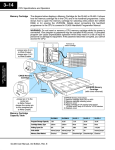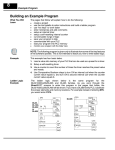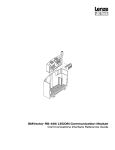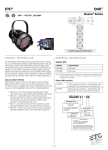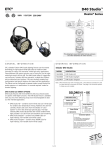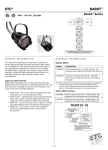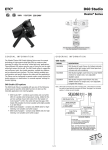Download DL330/DL330P/DL340 CPU Specifications
Transcript
DL330/DL330P/DL340 CPU Specifications In This Chapter. . . . — Overview — CPU Hardware Features — CPU Specifications — Selecting CPU Memory Options — DL330/DL330P CPU Setup — DL340 CPU Setup — DL340 Port Setup — Battery Backup — Installing the CPU — CPU Setup and System Functions 13 DL330/DL330P/DL340 Specifications DL330/DL330P/DL340 CPU Specifications DL330/DL330P/DL340 CPU Specifications DL330/DL330P/DL340 Specifications 3--2 DL330/DL330P/DL340 CPU Specifications Overview The CPU is the heart of the control system. Almost all system operations are controlled by the CPU, so it is important that it is set-up and installed correctly. This chapter provides the information needed to understand: S the differences between the different models of CPUs S the different memory options S the steps required to setup and install the CPU. The DL330 modular CPU is capable of controlling 176 I/O points and has 3.7K words of program storage. This CPU supports the RLL programing language and can save programs internally to RAM or UVPROM. There is a built-in programming port that directly supports the handheld programmer. DL330 CPU Features DL330P CPU Features The DL330P modular CPU is capable of controlling 176 I/O points and has 3.7K words program storage. This CPU supports the RLL PLUS programing language and can save programs internally to RAM or UVPROM. RLL PLUS provides a structured programming environment for Relay Ladder Logic through the addition of stage logic. There is a built-in port that directly supports the handheld programmer. DL340 CPU Features The DL340 modular CPU is capable of controlling 184 I/O points and has 3.7K words program storage. This CPU supports the RLL programming language and can save programs internally to RAM, UVPROM or EEPROM. There is a handheld programming port and two built-in RS232C ports for PC programming, operator interfaces, or networking. If you are using the DL340 in a DirectNET network, you can use either port as a slave port and the bottom port as a master. The bottom port has the additional capability of being configured as a slave on a Modbus® network. CPU Hardware Features CPU Status Indicators RUN ON OFF CPU is in RUN mode CPU is in Program mode BATT ON OFF Memory backup voltage low Memory backup voltage good ON OFF CPU failure (Error detected when the watchdog timer is not processed within 100ms. The run output from the power supply will be turned off.) CPU good ON OFF CPU power good CPU power failure ON CPU communication port receiving data CPU communication port not receiving data CPU PWR RX OFF TX ON OFF CPU communication port transmitting data CPU communication port not transmitting data DL305 User Manual, Rev. D CPU Slot DL330 DL330P RUN RUN BATT BATT CPU CPU LED Indicators Peripheral Port (HP, HPP, DCU, UVPROM Writer) Network Address Mode Switch POWER POWER RS232C Communication Ports --DirectSOFT --DirectNET --Operator Interfaces --Modbus® DL340 PWR RUN PORT1 TX/RX BATT PORT2 TX/RX CPU DL330/DL330P/DL340 CPU Specifications Feature DL330 DL330P DL340 Program memory (words) 3.7K 3.7K 3.7K Scan time/K ladder (boolean) 8 ms 20 ms .87 ms Supports Overrides No No Yes RLL (Relay Ladder Logic) Programming Yes Yes Yes RLL PLUS Programming No Yes No Handheld programmer with cassette tape interface Yes Yes Yes DirectSOFT programming for Windowst Yes Yes Yes Built-in communication ports (RS232C / DirectNET) No No Yes CMOS RAM Yes Yes Yes UVPROM Optional Optional Optional EEPROM No No Optional ASCII Basic modules Yes Yes Yes Networking modules Yes Yes Yes RS232C Data Communications Unit Yes Yes Yes RS422 Data Communications Unit Yes Yes Yes 110/220 VAC Yes Yes Yes 24 VDC (5 slot base only) Yes Yes Yes Local I/O 128 128 136 Local expansion I/O 176 176 184 Remote I/O NA NA NA Number of instructions available 61 65 61 Control relays 140 77 196 Shift register bits 128 uses CRs 128 Special relays (system defined) 12 11 20 None 128 None Timer/Counters 64 64 64 Data registers 128 128 192 Analog input channels max. 112 112 128 Analog output channels max. 28 28 32 Internal diagnostics Yes Yes Yes Password security Yes Yes Yes Battery backup Yes Yes Yes DL330/DL330P/DL340 Specifications CPU Specifications 3--3 Compatible with: DL305 User Manual, Rev. D DL330/DL330P/DL340 Specifications Stages (RLL PLUS only) DL330/DL330P/DL340 CPU Specifications Total I/O points using; DL330/DL330P/DL340 CPU Specifications Base Power Supply Available DL330/DL330P/DL340 CPU Specifications Selecting CPU Memory Options Internal Retentive Memory In addition to different choices for program storage, you can also select some memory areas to be retentive. Retentive memory retains its state after a power cycle or a program to run transition occurs, as long as the memory backup battery is functional. Non--retentive memory resets to a logical “0” after a power cycle or a program to run transition occurs. You have to use dipswitch to select the retentive memory options (the switches are discussed in the next section.) The following table shows the how the types of memory are defined. Some types of memory are automatically defined as retentive and other memory types can be defined as retentive as necessary for your application. The types of memory available depend on the type of CPU selected for your application. Retentive Memory Pre--defined Application program Yes User defined Stages (DL330P only) Yes Internal relays Yes Current count values Yes (full range) Shift register bits Yes (full range) Data registers Yes (full range) Password Yes External Program Storage All DL305 CPUs allow for program storage to be captured on external media such as cassette tape, floppy disk and hard disk. Refer to the DL305 Handheld Programmer manual for details on storing the CPU program to cassette tape. The DirectSOFT manual provides details on storing the CPU program to floppy or hard disk. Volatile and Non-volatile Memory There are two types of memory storage available, volatile and non-volatile. Volatile memory will retain your data as long as proper voltage is maintained to the storage media. Non-volatile memory does not require power to retain data. The DL305 CPUs maintain the proper voltage either through the base power supply or the use of the memory backup battery. DL330/DL330P/DL340 Specifications DL330/DL330P/DL340 CPU Specifications DL330/DL330P/DL340 CPU Specifications DL330/DL330P/DL340 Specifications 3--4 DL305 User Manual, Rev. D DL330/DL330P/DL340 CPU Specifications The type of program storage memory available to you depends on the CPU you are using. All DL305 CPUs support application program storage to either CMOS RAM or the optional UVPROM. The DL340 has the added option of supporting program storage in EEPROM. The application program can be up to 3.7K words. S CMOS RAM memory (Random Access Memory) is standard on all the DL305 CPUs. It is a volatile memory which can be modified or changed easily with a handheld programmer or PC programming software. S UVPROM (Ultraviolet Programmable Read Only Memory) is optional for all the DL305 CPUs. This type of memory is non--volatile and can only be erased with an ultraviolet light source. The PROM Writer Unit (D3--PWU) is used to copy your application program from the CPU’s RAM to a UVPROM. If the UVPROM has a program to be changed, it must be removed from the CPU and erased before another program can be copied on the UVPROM. S EEPROM (Electrically Erasable Programmable Read Only Memory) is an option only on the DL340 CPU. This type of memory is non--volatile, but can be electrically erased. The EEPROM can be electrically reprogrammed without being removed from the CPU, and without the use of a special external programming device. DL330/DL330P/DL340 Specifications WARNING: Be sure to use proper grounding techniques when touching UVPROMS and EEPROMS. A static discharge from you may cause damage to the PROM. If you do not have a ground strap, then ground yourself by touching the controller chassis before you make contact with the PROM. Also ensure that the surface where you place the PROM is properly grounded. DL330/DL330P/DL340 CPU Specifications Program Storage Memory Types (Internal) 3--5 DL330/DL330P/DL340 CPU Specifications DL330/DL330P/DL340 Specifications DL305 User Manual, Rev. D DL330/DL330P/DL340 Specifications 3--6 DL330/DL330P/DL340 CPU Specifications Storing Programs on UVPROMs The PROM Writer Unit is only compatible with DL305 CPUs and UVPROMs. It can perform the following three functions: S Copy a program from the CPU’s RAM to a UVPROM S Copy a program from the UVPROM to the CPU’s RAM S Compare the program in the UVPROM with the CPU’s RAM Operation Selection Buttons UVPROM Socket UVPROM BLANK WRITE VERIFY DL330/DL330P/DL340 Specifications DL330/DL330P/DL340 CPU Specifications DL330/DL330P/DL340 CPU Specifications ERR Socket Lever used to lock down and release UVPROM during write procedure The LED for the selected function will turn off when completed (except for the error reset function). If any error is encountered, one of the LEDs in the following table will be on and the execution of the selected function will be stopped. Function Key Operation LED Display Remarks Errors Flagged Copies the content of WRITE the CPU RAM into the UVPROM ~WRITE Automatic comparison Constant on indicates is made after a write failure. checking and writing. Copies the content of the UVPROM into the CPU RAM WRITE VERIFY ~WRITE ~VERIFY Depress two keys at the same time. Comparison is made after transferring. To verify the content of the UVPROM with the CPU RAM VERIFY ~VERIFY Constant on indicates an unmatched address. To check if the UVPROM is blank. BLANK ~BLANK Constant on indicates a non-blank address is found. Error reset ERR ~ERR Return to the initial condition by pressing this key if an error condition is noted. On indicates an error. ~CPU Red On indicates failure. ~PWR Green On indicates DC power is within tolerance. Off indicates DC power not within tolerance. DL305 User Manual, Rev. D DL330/DL330P/DL340 CPU Specifications The PROM Writer Unit connects directly to either a DL330, DL330P or DL340 CPU. Use the following steps to connect the PROM Writer Unit: 1. Set the power supply source switch (on the back of the unit) to the appropriate power source setting, (INT for using base power and EXT for an external power source). The PROM Writer Unit can either use the local CPU base power or use an external power source. NOTE: If you are using the local CPU base power you will need to include the Prom Writer Unit power consumption in your power budget. The power budget is covered in Chapter 4. DL330/DL330P/DL340 CPU Specifications DL330/DL330P/DL340 Specifications DL305 User Manual, Rev. D DL330/DL330P/DL340 CPU Specifications 2. If using an external power source attach the supplied cable to the power source socket on the back of the unit. The white wire should be connected to +5VDC and the black wire should be connected to DC ground. 3. Turn off the power source to the base before attaching the PROM Writer Unit. 4. Attach the PROM Writer Unit to the CPU. The connector on the back of the unit will mate with the programming port (PRG) of the CPU. Tighten the fixture screw to secure the two units together. 5. Apply power to the local CPU base and if necessary to the PROM Writer Unit. Once the PWR LED is on it will take approximately 10 seconds for the unit to initialize. During this time keystrokes will not be recognized. Copying a Program The following steps explain how to copy a program from the CPU RAM to a From the CPU RAM UVPROM: 1. Turn power on. to a UVPROM 2. Raise the UVPROM socket lever. 3. Insert the UVPROM (notch up) in the socket and lower the lever. 4. Press the “WRITE” button. The following sequence of events will take place: S The WRITE LED will turn on then off. S The BLANK LED will come on. (This notes the checking sequence to ensure that the UVPROM is blank has started.) S The BLANK LED will turn off and the WRITE LED will turn on. S The WRITE LED will turn off and the VERIFY LED will turn on. (This indicates that the write is complete. While the VERIFY LED is on, a comparison between the UVPROM and the CPU RAM is being made.) S The VERIFY LED will turn off. (This indicates the end of the copying function.) S If an error has been detected, the ERR LED will come on. If this happens press the “ERR” key to clear the error and the “WRITE” key to repeat the procedure. If this does not correct the problem, repeat the procedure using a different UVPROM. 5. Turn power off, raise the UVPROM socket lever and remove UVPROM. DL330/DL330P/DL340 Specifications Setting up the PROM Writer Unit 3--7 DL330/DL330P/DL340 Specifications 3--8 DL330/DL330P/DL340 CPU Specifications Copying a Program The following steps explain how to copy a program from the UVPROM to the CPU From the UVPROM RAM: 1. Turn power on. to the CPU RAM 2. Raise the UVPROM socket lever. 3. Insert the UVPROM (notch up) in the socket and lower the lever. 4. Simultaneously press “WRITE” and “VERIFY” buttons. The following sequence of events will take place: S The BLANK, WRITE and VERIFY LEDs will all come on momentarily. S The WRITE LED turns off. S The VERIFY LED will stay on till the operation is completed. S If an error has been detected, the ERR LED will come on. If this happens, press the “ERR” key to clear the error and repeat step 4. 5. Turn power off, raise the UVPROM socket lever and remove UVPROM. The following steps show how to compare a UVPROM program to the CPU RAM: 1. Turn power on. 2. Raise the UVPROM socket lever. 3. Insert the UVPROM (notch up) in the socket and lower the lever. 4. Press the “VERIFY” button. The following sequence of events will take place: S The VERIFY LED indicator will come on. S If verification is successful, the VERIFY LED will go off. S If there is an error in the comparison the VERIFY LED will remain on. 5. Turn power off, raise the UVPROM socket lever and remove UVPROM. Erasing a UVPROM UVPROMS can be erased through exposure to an ultraviolet light source. Make sure that the window to the UVPROM is not covered so that it may receive full exposure to the light source. A typical exposure would be: 12,000μ w/cm2 lamp @ 2.5 cm for 15--20 minutes. DL330/DL330P/DL340 Specifications DL330/DL330P/DL340 CPU Specifications DL330/DL330P/DL340 CPU Specifications Comparing a Program From the UVPROM to the CPU RAM DL305 User Manual, Rev. D DL330/DL330P/DL340 CPU Specifications 3--9 Installing the S UVPROM Option in the DL330 / DL330P CPU S S S S S S Disconnect the power from the base and allow approximately 60 seconds for the capacitor to discharge before removing the CPU. Disconnect the battery wires from the CPU. Remove the RAM chip from IC socket. Align the UVPROM notch with the IC socket notch on the CPU card. Carefully insert the UVPROM in the IC socket. Set dip switch 2 and Jumpers 1 -- 3 for UVPROM (ROM). Reconnect the battery wires to CPU. Memory Type Switch RAM UVPROM (ROM) JUMPER 1 DL330/DL330P/DL340 Specifications DL330/DL330P CPU Setup JUMPER 2 JUMPER 3 DIPSWITCH 2 (on) (off) ON 2 Dipswitch 1 (ON selects power failure Dipswitch 2 (ON -- RAM retention) OFF -- UVPROM) BATTERY ROM Jumper 1 RAM/UVPROM Jumper 2 RAM RAM Jumper 3 Selecting Retentive The DL330 and DL330P have a dipswitch which can be used to turn on or off power failure retention for specific relays and stages. (Some memory types are Memory for the automatically retentive.) The following diagram lists the range of retentive memory DL330 / DL330P for the memory types that are covered by the selection switch. ON BATTERY ROM RAM/UVPROM ROM DL330/DL330P Networking RAM 1 2 RAM Internal relays in the DL330P range from 160 -- 277, only 200 -- 277 can be set retentive or non--retentive. Stages in the DL330P range from SG000 to SG177, only SG000 to SG137 can be set retentive or non--retentive. Networking for the DL330 and DL330P is accomplished by using a DCU, (Data Communications Unit, RS232C part number D3-232-DCU, RS422 part number D3-422-DCU). DL305 User Manual, Rev. D DL330/DL330P/DL340 Specifications Dipswitch 1 Internal relays in the DL330 range from (on selects 160 -- 373, only 340 -- 373 can be set power failure retentive or non--retentive. retention) DL330/DL330P/DL340 CPU Specifications ROM DL330/DL330P/DL340 CPU Specifications 1 DL330/DL330P/DL340 Specifications 3--10 DL330/DL330P/DL340 CPU Specifications DL340 CPU Setup Installing the optional UVPROM or EEPROM in the DL340 CPU Complete the following steps to install the optional memory. 1. Disconnect the power from the base and allow approximately 60 seconds for the capacitor to discharge before removing the CPU. 2. Disconnect the battery wires from the CPU. 3. Align the UVPROM/EEPROM notch with the IC socket notch on the CPU. 4. Carefully insert the UVPROM/EEPROM into the IC socket. 5. Set dipswitch SW1, bit 1 and the short Jumpers N/C -- 4 for the option you have installed. 6. Reconnect the battery wires to the CPU. Memory Type Switch RAM SHORT PIN JUMPERS DL330/DL330P/DL340 CPU Specifications DL330/DL330P/DL340 CPU Specifications 1 DIPSWITCH SW1 -- Bit 1 2 EEPROM 3 4 ... 1 2 3 4 UVPROM (ROM) EEPROM (WRITE PROTECTED) ... 1 2 3 4 ... 1 ON ON ON ON OFF OFF OFF OFF N/C 2 3 4 N/C 2 3 4 N/C 2 3 4 DL330/DL330P/DL340 Specifications 3 4 N/C 2 3 4 N/C 2 DL305 User Manual, Rev. D 2 3 4 ... DL330/DL330P/DL340 CPU Specifications 3--11 Retentive Memory Switch ON DIPSWITCH SW1 -- Bit 2 OFF 1 2 3 4 5 6 7 8 Non--Retentive Memory ON 1 2 3 4 5 6 7 8 DL330/DL330P/DL340 Specifications Selecting Retentive The DL340 uses the same dipswitch for selecting memory retention as was used for memory type selection. Dipswitch SW1, bit 2 is used to set memory retention for the Memory for the ranges of internal relays shown in the following diagram. DL340 OFF Internal relays in the DL340 range from 160 to 373 and 1000 to 1067, only 340 -- 373 can be set retentive or non--retentive. DL330/DL330P/DL340 CPU Specifications DL330/DL330P/DL340 CPU Specifications DL330/DL330P/DL340 Specifications DL305 User Manual, Rev. D DL330/DL330P/DL340 Specifications 3--12 DL340 Port Setup DL340 Baud Rate Selection The following chart shows how to configure the baud rate for Port 1 (RS232C) of the DL340 using dipswitch SW1, switches 3, 4 and 5. Port 2 baud rate is set by using a programming device to enter the baud rate in address R773 (in BCD or HEX). Port 1 Port 2 Sample Setup Ladder Logic Port 1 300 Baud Port 1 4800 Baud ON 1 2 3 4 5 6 7 8 ON 1 2 3 4 5 6 7 8 Baud R773 C374 DSTR 300 1 OFF OFF K006 Port 1 600 Baud Port 1 9600 Baud 600 2 1st scan only. ON 1 2 3 4 5 6 7 8 ON 1 2 3 4 5 6 7 8 Set baud rate to 9600 1200 3 DOUT1 SW1 2400 4 OFF OFF R773 Port 1 1200 Baud Port 1 19200 Baud 4800 5 1st scan only. ON 1 2 3 4 5 6 7 8 ON 1 2 3 4 5 6 7 8 C374 9600 6 DSTR K500 19200 7 OFF OFF Port 1 2400 Baud Port 1 38400 Baud Set network address to 5 38400 8 ON 1 2 3 4 5 6 7 8 ON 1 2 3 4 5 6 7 8 9600 0, 9 to FF DOUT DL330/DL330P/DL340 CPU Specifications DL330/DL330P/DL340 CPU Specifications OFF DL330/DL330P/DL340 Specifications DL330/DL330P/DL340 CPU Specifications R771 OFF DL340 Network Address Selection Network Addressing RAM/UVPROM DL340 PWR RUN PORT1 TX/RX BATT PORT2 TX/RX CPU Fixed Station Network Address Mode Switch Selectable Address Switch Station Address FIXED FIXED USER USER (Network Address (Network Address set to is set to 01) 3 by rotary switches) SW4 SW3 Port 1 Port 2 Most Significant Digit Least Significant Digit Port 1 (RS232C): Network address selection is accomplished with the Network Address Mode Switch and the two rotary switches 3 and 4. The address is set in BCD. Network Address Mode Switch sets fixed or selectable network address. Rotary Switch 3 sets the least significant decimal digit of the network address. Rotary Switch 4 sets the most significant decimal digit of the network address. In the example above, when the Network mode switch is set to FIXED the network address will default to 01, when the Network mode switch is set to USER the network address (set with the rotary switches) is 03. Note, if the rotary switches are set to 00, the network address will default to 01. Port 2 (RS232C): Network address selection is set by using a programming device to enter the value for the most significant digit and least significant digit in addresses R771 and R772 respectively. The address is set in BCD. If you’re using MODBUS RTU protocol on Port 2, the MODBUS address is set in decimal, not BCD. Load the lower two digits in R771 and the upper two digit(s) in R772. DL305 User Manual, Rev. D 3--13 DL330/DL330P/DL340 CPU Specifications PIN NumberSignal 1 RXD 2 TXD 3 RTS 4 GND RS232C Communication Port Specifications Connector Network Address Baud Rate Parity Transfer Mode GND Data bits Start bits Stop bits Turn Around Delay CTS RTS TXD RXD DL340 Station Type Selection and Address Ranges RJ11 (handset connector) 01 to 90 38400, 19200, 9600, 4800, 2400, 1200, 600, 300 None / Odd Hex / ASCII Half-duplex Asynchronous 8 1 1 0 to 1980 in 20 ms intervals (preset with R777) The station type for Port 1 is fixed as a Slave and cannot be changed. The station type for Port 2 can be selected by setting the appropriate switch positions (6 and 7) on the SW1 switch bank. Bit 6 Bit 7 Protocol Address Range 1 N/A N/A Slave 1 -- 90 2 Off Off On On Off On Off On Slave/DirectNET Master/DirectNET Peer/DirectNET Modbus®/RTU 1 1 1 1 ----- 90 90 90 247 RS232C Request to Send Port On Delay Off Delay Port 1 R776 R777 Port 2 R774 R775 400 ms 100 ms On delay Off delay RS232C Transmit Data R776 = 20, 20 x 20ms intervals = 400ms on delay R777 = 5, 5 x 20ms intervals = 100ms off delay A special propose control relay is used to select between ASCII and HEX transmission modes on the DirectNET network. When this relay is off, HEX mode is used. When this relay is turned on, ASCII mode is used. Off is the default state. S Port 1 C1077 S Port 2 C1076 DL340 Selecting Parity for Port 2 DL340 CPUs with firmware V2.7 or later allow you to select the parity for Port 2. The default setting is none. A special propose control relay (C1072) is used to select between odd parity (relay is on) and no parity (relay is off). S Port 2 C1072 DL305 User Manual, Rev. D DL330/DL330P/DL340 Specifications DL340 Selecting Data Format (ASCII/HEX) DL330/DL330P/DL340 CPU Specifications You can use the Handheld Programmer or DirectSOFT to select an on and off response delay time of up to 1980 ms. The time delay is calculated based on a preset number that is loaded into two memory locations. These presets indicate the number of 20 ms intervals that will be used as the delay. For example, an entry of 2 would result in a 40 ms response delay time. DL330/DL330P/DL340 CPU Specifications Port SW1 DL340 Selecting the Response Delay Time DL330/DL330P/DL340 Specifications DL340 RS232C Port (1 and 2) Pin Outs DL330/DL330P/DL340 Specifications 3--14 DL330/DL330P/DL340 CPU Specifications Battery Backup Memory Battery Backup The DL305 CPUs have a lithium battery to retain the application program and retentive memory when the system is not receiving power from the power supply. Typical battery life is five years. This time period includes PLC runtime and normal shutdown periods such as preventative maintenance and power outages. The CPU has indicators which tell when it is necessary to change the battery. However, if your battery has been in your system for an extended period of time, you may wish to take added precautions to ensure that the system memory will be retained by installing a new battery when shutting the system down for a period of more than ten days. DL330/DL330P/DL340 CPU Specifications DL330/DL330P/DL340 Specifications WARNING: If the battery connector is not connected to the PC board or the battery is not installed, the indicator will not notify you of the error. Be sure the battery is in place and the connector is firmly seated before you install the CPU into the base. 2) Unplug connector 1) Push back retaining clip 2) Unplug connector 1) Push back retaining clip DL330 3) Remove battery Part #D3--D4-BATT 3) Remove battery Part #D3--D4-BATT RAM/UVPROM DL330/DL330P/DL340 CPU Specifications NOTE: Before replacing your CPU battery, you should back-up your application program. This can be done by saving the program to hard/floppy disk on a personal computer or using the handheld programmer along with a cassette tape recorder. The CPU has a built-in capacitor to retain the memory for several minutes while the battery is being replaced. DL330, DL330P, To replace the CPU battery: DL340 CPU Battery 1. Turn power off to the system. Replacement 2. Wait 60 seconds then remove the CPU. Do not short any connectors or components on the CPU since it may alter the program memory. 3. Unlatch and tilt the clip covering the battery. 4. Pull the two wire battery connector from the PC board and remove the battery. WARNING: Do not attempt to recharge the battery or dispose of it by fire. The battery may explode or release hazardous materials. To install the CPU battery: 1. Plug the (keyed) two wire battery connector on the battery into the connector on the PC board. 2. Push gently till the connector snaps closed 3. Slide the battery under the battery retaining clip till the battery is positioned in the socket. 4. Push the retaining clip down over the battery snapping the clip over the edge of the PC board. 5. Note the date the battery was changed. DL305 User Manual, Rev. D DL330/DL330P/DL340 CPU Specifications 3--15 Before you complete these steps, make sure you have set the dipswitches and/or jumpers needed to support your application. WARNING: To minimize the risk of electrical shock, personal injury, or equipment damage, always disconnect the system power before installing or removing any system component. DL330/DL330P/DL340 Specifications Installing the CPU When inserting the CPU into the base, align the PC board with the grooves on the top and bottom of the base. Push the CPU straight into the base until it is firmly seated in the backplane connector. DL330/DL330P/DL340 CPU Specifications Align module to slots in base and slide in DL330/DL330P/DL340 CPU Specifications DL330/DL330P/DL340 Specifications DL305 User Manual, Rev. D DL330/DL330P/DL340 CPU Specifications CPU Setup and System Functions A Few Things to Know Even if you have years of experience using PLCs, there are a few things you need to do before you can start entering programs. This section includes some basic things, such as changing the CPU mode and connecting a programming device. Here is a list of the items that are discussed. S Auxiliary Functions S Connecting a Programming Device S Changing the CPU Modes S Clearing the CPU memory The following paragraphs provide the setup information necessary to get the CPU ready for programming. The actual setup information depends on the type of programming device you are using. For example, the DL305 Handheld Programmer manual provides the Handheld keystrokes required to perform all of these operations. The DirectSOFT manual provides a description of the menus and keystrokes required to perform the setup procedures via DirectSOFT. DL330/DL330P/DL340 Specifications DL330/DL330P/DL340 CPU Specifications DL330/DL330P/DL340 CPU Specifications DL330/DL330P/DL340 Specifications 3--16 DL305 User Manual, Rev. D 3--17 DL330/DL330P/DL340 CPU Specifications Many CPU tasks involve the use of predefined functions. These are often called Auxiliary (AUX) Functions. The AUX Functions perform many different operations, ranging from simple operating mode changes to determining the firmware revision number. You can access all of the AUX Functions from DirectSOFT menu options, but not from the DL305 Handheld Programmer. You can still perform some of the operations with the Handheld Programmer, but they are accomplished by using a certain series of keystrokes rather than by entering a specific AUX function. NOTE: Neither DirectSOFT or the Handheld Programmer utilize the numbers shown for the AUX functions. These numbers have been included because many of you may already have existing software packages that can be used with these CPUs. If you do already have an existing software package, remember that any additional features (such as added I/O, CRs, etc. available with the DL340 CPU) may not be accessible. AUX Function and Description DL330, DL330P, DL340 AUX 1* — Diagnostics and PLC Modes Software HP 10 Program Syntax Check (Grammar check) P P Compare PLC to Disk P PLC Operational Mode P P 13 Revision Number P Software HP AUX 3* — Clear PLC Memory 31 Ladders P P 32 Data Registers P 33 Timer / Counter Accumulators AUX 6* — Save Data from PLC P Software HP Ladders P P 62 Data Registers P AUX 9* — Load Data to PLC 91 Ladders P P 92 Data Registers P P P Password Operations None Password — Function or keystrokes available X — Not available P DL330/DL330P/DL340 CPU Specifications 61 DL330/DL330P/DL340 CPU Specifications 11 12 DL330/DL330P/DL340 Specifications What are Auxiliary Functions? DL330/DL330P/DL340 Specifications DL305 User Manual, Rev. D DL330/DL330P/DL340 CPU Specifications Connecting the Programming Devices You can mount the Handheld directly to the port of the CPU, or you can use a cable. The cable, part number D3--HPCBL, is approximately 4.5 feet (1.5m) in length and provides more flexibility. There are two different handheld programmers for the DL305 CPUs. The D3--HP can be used with either the DL330 or the DL340. The D3--HPP can only be used with the DL330P. The D3--HPP supports the RLL PLUS features. If you’re using a Personal Computer with the DirectSOFT programming package, a Data Communications Unit (either RS232C or RS422) must be used to interface to the DL330/DL330P CPUs. DCUs may also be used to establish a connection between the DL305 and an operator interface or a network. The DL340 CPU provides two built-in RS232C ports which can be used to directly connect to a personal computer, operator interface or network. The DCU may also be used with the DL340 if the built-in ports are otherwise occupied. DL330/DL330P/DL340 Specifications DL330/DL330P/DL340 CPU Specifications DL330/DL330P/DL340 CPU Specifications DL330/DL330P/DL340 Specifications 3--18 DL305 User Manual, Rev. D DL330/DL330P/DL340 CPU Specifications Handheld Programmer DL340 CPU with 2 Built-in RS232C Communication Ports DL330/DL330P/DL340 Specifications Programming the DL340 CPU with either the Handheld programmer or the PC 3--19 RS232C Connect to either port DL330 or DL330P DCU RS232C or RS422 Handheld Programmer DL330/DL330P/DL340 CPU Specifications RS232C or RS422 DL330/DL330P/DL340 CPU Specifications Programming the DL330 CPU with either the Handheld programmer or the PC (using a Data Communication Unit) DL330/DL330P/DL340 Specifications DL305 User Manual, Rev. D DL330/DL330P/DL340 CPU Specifications Changing the CPU There are two modes of operation for the DL305 CPUs: Mode of Operation S RUN — executes the application program and updates I/O modules S PGM — allows program entry, does not execute the application program or update I/O modules The CPU modes for all DL305 CPUs can be changed by using either a Handheld Programmer or DirectSOFT. The DL330 and DL330P require a Data Communications Unit when using DirectSOFT. This is discussed later in this chapter. Since the DL340 has the possibility of being accessed through multiple ports at the same time, the Handheld Programmer and DCU have priority over the built-in RS232C ports during mode change operations. If no Handheld Programmer or DCU is online, DirectSOFT can perform mode changes through either of the built-in ports. When the Handheld Programmer or DCU is online and a mode change is attempted with DirectSOFT, the Handheld Programmer or DCU will immediately change the mode back to the original mode. This forces the CPU mode to always correspond with the keyswitch position on the Handheld Programmer. WARNING: The CPU will automatically change modes when you connect the Handheld Programmer if the keyswitch is set for a different mode of operation. For example, if the CPU is in Run mode and the Handheld Programmer keyswitch is set to the PRG (Program) position, the CPU will automatically enter Program mode when the Handheld is connected. DL330/DL330P/DL340 CPU Specifications DL330/DL330P/DL340 CPU Specifications DL330/DL330P/DL340 Specifications 3--20 RUN PRG LOAD TAPE DL330/DL330P/DL340 Specifications The LOAD position is used for uploading a program from CPU memory to a cassette tape, or downloading a program from cassette tape to CPU memory. DL305 User Manual, Rev. D DL330/DL330P/DL340 CPU Specifications Before you enter a new program, you should always clear the CPU memory. Only a few keystrokes are required. The next few steps show how to clear the CPU memory using the handheld programmer. Put the handheld programmer’s key switch in the PRG position. Attach the handheld programmer directly to the front of the CPU making sure that the port on the back of the programmer aligns properly with the port on the CPU and the programmer’s latches connect with the slots in the base power supply. Apply power to the base. LED’s on the programmer will display indicating a good connection. Handheld Programmer You can clear the memory by using the PLC/Clear PLC sub-menu from within DirectSOFT, or you can use the following Handheld Programmer keystrokes. CLR ADDRESS/DATA ON/OFF RUN BATT CLR SHF 3 4 8 4 OUT 5 TMR 6 CNT 7 SR DEL 0 MCS 1 MCR 2 SET 3 RST NXT 4 ADR 5 SHF 6 DATA 7 REG (Clears the CPU memory) NOTE: This Handheld Programmer operation only clears the program memory. Any values stored in data registers are not cleared. You do have an additional menu option within DirectSOFT that allows you to clear the data registers. CPU Checklist DL305 User Manual, Rev. D DL330/DL330P/DL340 Specifications Before you proceed with the I/O configuration or programming information, make sure you have: S set the CPU dipswitches S selected and installed the EEPROM/UVPROM (if chosen.) S a good understanding of the various system functions needed to setup the CPU. DL330/DL330P/DL340 CPU Specifications PWR CPU 0 AND 1 OR 2 STR 3 NOT DL330/DL330P/DL340 CPU Specifications Key switch in PRG mode DL330/DL330P/DL340 Specifications Clearing the CPU Memory 3--21






















